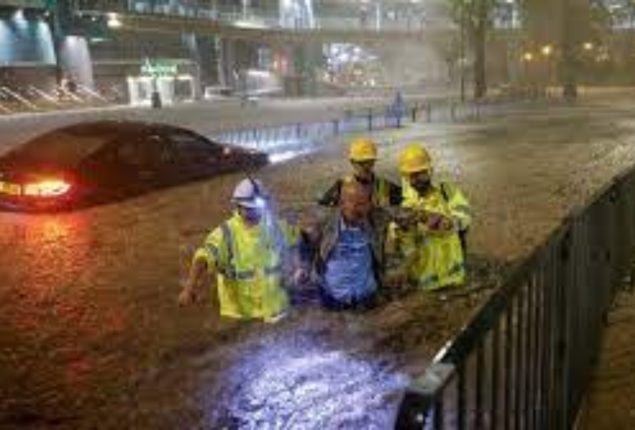
Record Rains Batter Hong Kong, Cause Widespread Flooding
- Heavy rainfall in Hong Kong and southern China causes widespread flooding.
- Streets, subway stations, and shopping centers were submerged.
- Over 100 people were hospitalized, and numerous rescue operations are underway.
Hong Kong and several cities in southern China are grappling with severe flooding due to the heaviest rainfall in over 140 years.
The situation escalated on Friday, resulting in submerged streets and subway stations in Hong Kong, leading authorities to close schools and workplaces.
Emergency services have been overwhelmed, with over 100 people hospitalized and numerous rescue operations underway.
A black weather warning was issued as images depicted the deluge transforming streets into raging rivers, inundating shopping centers and crippling public transportation.
Social media captured individuals clambering onto vehicles and elevated structures to escape the rising waters, which, in some areas, reached several meters in height, even obstructing subway entrances.
The black warning was declared on Thursday when rainfall exceeded 70mm per hour, and later that night, the Hong Kong Observatory recorded an hourly rainfall of 158.1 millimeters, the highest on record since 1884.
Critical infrastructure like the cross-harbor tunnel connecting the main island to Kowloon was inundated, and landslides occurred in Hong Kong’s mountainous regions, blocking highways.
By Friday afternoon, the downpours had subsided somewhat, prompting authorities to downgrade the rainstorm warning from “black” to “amber.” However, they cautioned that showers were expected to persist until Saturday.
Between 6:00 PM local time and midnight, over 200mm of rain was recorded in various parts of Hong Kong, exceeding the typical monthly rainfall in the city.
Southern China also experienced heavy rainfall, with Shenzhen, located across the border from Hong Kong, reporting its most substantial showers since records began in 1952.
This led to the suspension of hundreds of flights in Guangdong province, and local authorities urged residents in low-lying areas to consider evacuations.
In response to concerns raised online about whether Shenzhen’s release of water from its reservoirs worsened Hong Kong’s flooding,
Hong Kong’s security chief, Chris Tang, clarified on Friday that the discharge had no impact on the city’s floods and was safe for both Shenzhen and Hong Kong.
China’s meteorological administration expects extreme rainfall to continue in the southwestern region of the country on Friday and Saturday.
This deluge follows closely on the heels of two recent typhoons, Saola and Haikui, which hit southern China in rapid succession, prompting a citywide shutdown in Hong Kong.
The intensification and increased frequency of tropical storms due to climate change have led to more flash flooding and greater damage in the affected regions.
Read More News On
Catch all the World News, Breaking News Event and Latest News Updates on The BOL News
Download The BOL News App to get the Daily News Update & Follow us on Google News.




